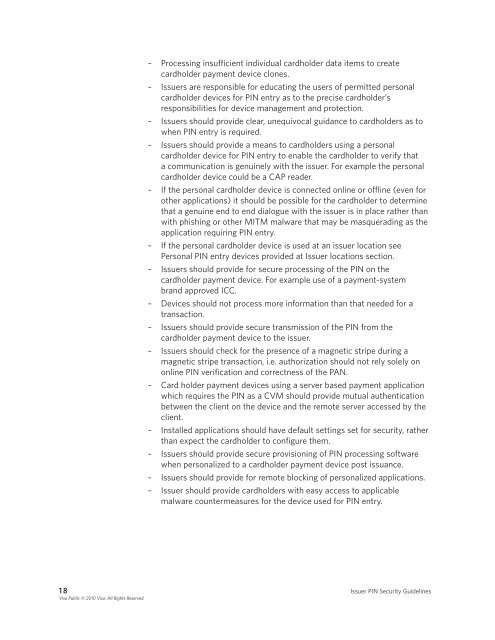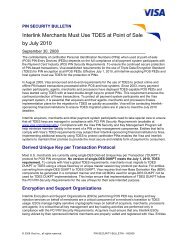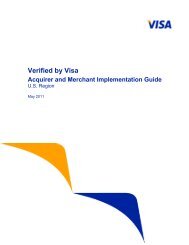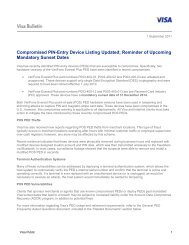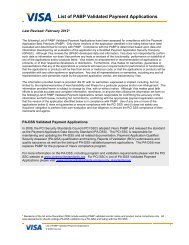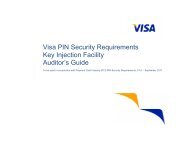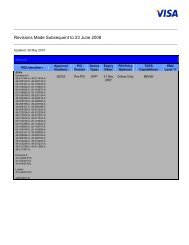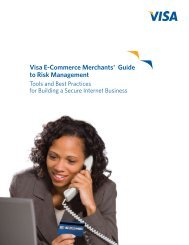Issuer PIN Security Guidelines - Visa
Issuer PIN Security Guidelines - Visa
Issuer PIN Security Guidelines - Visa
Create successful ePaper yourself
Turn your PDF publications into a flip-book with our unique Google optimized e-Paper software.
– Processing insufficient individual cardholder data items to create<br />
cardholder payment device clones .<br />
– <strong>Issuer</strong>s are responsible for educating the users of permitted personal<br />
cardholder devices for <strong>PIN</strong> entry as to the precise cardholder’s<br />
responsibilities for device management and protection .<br />
– <strong>Issuer</strong>s should provide clear, unequivocal guidance to cardholders as to<br />
when <strong>PIN</strong> entry is required .<br />
– <strong>Issuer</strong>s should provide a means to cardholders using a personal<br />
cardholder device for <strong>PIN</strong> entry to enable the cardholder to verify that<br />
a communication is genuinely with the issuer . For example the personal<br />
cardholder device could be a CAP reader .<br />
– If the personal cardholder device is connected online or offline (even for<br />
other applications) it should be possible for the cardholder to determine<br />
that a genuine end to end dialogue with the issuer is in place rather than<br />
with phishing or other MITM malware that may be masquerading as the<br />
application requiring <strong>PIN</strong> entry .<br />
– If the personal cardholder device is used at an issuer location see<br />
Personal <strong>PIN</strong> entry devices provided at <strong>Issuer</strong> locations section .<br />
– <strong>Issuer</strong>s should provide for secure processing of the <strong>PIN</strong> on the<br />
cardholder payment device . For example use of a payment-system<br />
brand approved ICC .<br />
– Devices should not process more information than that needed for a<br />
transaction .<br />
– <strong>Issuer</strong>s should provide secure transmission of the <strong>PIN</strong> from the<br />
cardholder payment device to the issuer .<br />
– <strong>Issuer</strong>s should check for the presence of a magnetic stripe during a<br />
magnetic stripe transaction, i .e . authorization should not rely solely on<br />
online <strong>PIN</strong> verification and correctness of the PAN .<br />
– Card holder payment devices using a server based payment application<br />
which requires the <strong>PIN</strong> as a CVM should provide mutual authentication<br />
between the client on the device and the remote server accessed by the<br />
client .<br />
– Installed applications should have default settings set for security, rather<br />
than expect the cardholder to configure them .<br />
– <strong>Issuer</strong>s should provide secure provisioning of <strong>PIN</strong> processing software<br />
when personalized to a cardholder payment device post issuance .<br />
– <strong>Issuer</strong>s should provide for remote blocking of personalized applications .<br />
– <strong>Issuer</strong> should provide cardholders with easy access to applicable<br />
malware countermeasures for the device used for <strong>PIN</strong> entry .<br />
1 8 <strong>Issuer</strong> <strong>PIN</strong> <strong>Security</strong> <strong>Guidelines</strong><br />
<strong>Visa</strong> Public © 2010 <strong>Visa</strong>. All Rights Reserved.


